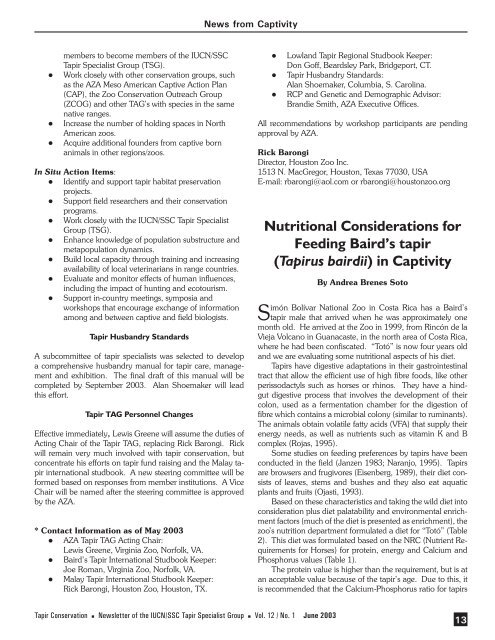Download now - Tapir Specialist Group
Download now - Tapir Specialist Group
Download now - Tapir Specialist Group
You also want an ePaper? Increase the reach of your titles
YUMPU automatically turns print PDFs into web optimized ePapers that Google loves.
members to become members of the IUCN/SSC<br />
<strong>Tapir</strong> <strong>Specialist</strong> <strong>Group</strong> (TSG).<br />
l Work closely with other conservation groups, such<br />
as the AZA Meso American Captive Action Plan<br />
(CAP), the Zoo Conservation Outreach <strong>Group</strong><br />
(ZCOG) and other TAG’s with species in the same<br />
native ranges.<br />
l Increase the number of holding spaces in North<br />
American zoos.<br />
l Acquire additional founders from captive born<br />
animals in other regions/zoos.<br />
In Situ Action Items:<br />
l Identify and support tapir habitat preservation<br />
projects.<br />
l Support field researchers and their conservation<br />
programs.<br />
l Work closely with the IUCN/SSC <strong>Tapir</strong> <strong>Specialist</strong><br />
<strong>Group</strong> (TSG).<br />
l Enhance k<strong>now</strong>ledge of population substructure and<br />
metapopulation dynamics.<br />
l Build local capacity through training and increasing<br />
availability of local veterinarians in range countries.<br />
l Evaluate and monitor effects of human influences,<br />
including the impact of hunting and ecotourism.<br />
l Support in-country meetings, symposia and<br />
workshops that encourage exchange of information<br />
among and between captive and field biologists.<br />
<strong>Tapir</strong> Husbandry Standards<br />
A subcommittee of tapir specialists was selected to develop<br />
a comprehensive husbandry manual for tapir care, management<br />
and exhibition. The final draft of this manual will be<br />
completed by September 2003. Alan Shoemaker will lead<br />
this effort.<br />
<strong>Tapir</strong> TAG Personnel Changes<br />
Effective immediately, Lewis Greene will assume the duties of<br />
Acting Chair of the <strong>Tapir</strong> TAG, replacing Rick Barongi. Rick<br />
will remain very much involved with tapir conservation, but<br />
concentrate his efforts on tapir fund raising and the Malay tapir<br />
international studbook. A new steering committee will be<br />
formed based on responses from member institutions. A Vice<br />
Chair will be named after the steering committee is approved<br />
by the AZA.<br />
* Contact Information as of May 2003<br />
l AZA <strong>Tapir</strong> TAG Acting Chair:<br />
Lewis Greene, Virginia Zoo, Norfolk, VA.<br />
l Baird’s <strong>Tapir</strong> International Studbook Keeper:<br />
Joe Roman, Virginia Zoo, Norfolk, VA.<br />
l Malay <strong>Tapir</strong> International Studbook Keeper:<br />
Rick Barongi, Houston Zoo, Houston, TX.<br />
News from Captivity<br />
<strong>Tapir</strong> Conservation n Newsletter of the IUCN/SSC <strong>Tapir</strong> <strong>Specialist</strong> <strong>Group</strong> n Vol. 12 / No. 1 June 2003<br />
l Lowland <strong>Tapir</strong> Regional Studbook Keeper:<br />
Don Goff, Beardsley Park, Bridgeport, CT.<br />
l <strong>Tapir</strong> Husbandry Standards:<br />
Alan Shoemaker, Columbia, S. Carolina.<br />
l RCP and Genetic and Demographic Advisor:<br />
Brandie Smith, AZA Executive Offices.<br />
All recommendations by workshop participants are pending<br />
approval by AZA.<br />
Rick Barongi<br />
Director, Houston Zoo Inc.<br />
1513 N. MacGregor, Houston, Texas 77030, USA<br />
E-mail: rbarongi@aol.com or rbarongi@houstonzoo.org<br />
Nutritional Considerations for<br />
Feeding Baird’s tapir<br />
(<strong>Tapir</strong>us bairdii) in Captivity<br />
By Andrea Brenes Soto<br />
S imón Bolívar National Zoo in Costa Rica has a Baird’s<br />
tapir male that arrived when he was approximately one<br />
month old. He arrived at the Zoo in 1999, from Rincón de la<br />
Vieja Volcano in Guanacaste, in the north area of Costa Rica,<br />
where he had been confiscated. “Totó” is <strong>now</strong> four years old<br />
and we are evaluating some nutritional aspects of his diet.<br />
<strong>Tapir</strong>s have digestive adaptations in their gastrointestinal<br />
tract that allow the efficient use of high fibre foods, like other<br />
perissodactyls such as horses or rhinos. They have a hindgut<br />
digestive process that involves the development of their<br />
colon, used as a fermentation chamber for the digestion of<br />
fibre which contains a microbial colony (similar to ruminants).<br />
The animals obtain volatile fatty acids (VFA) that supply their<br />
energy needs, as well as nutrients such as vitamin K and B<br />
complex (Rojas, 1995).<br />
Some studies on feeding preferences by tapirs have been<br />
conducted in the field (Janzen 1983; Naranjo, 1995). <strong>Tapir</strong>s<br />
are browsers and frugivores (Eisenberg, 1989), their diet consists<br />
of leaves, stems and bushes and they also eat aquatic<br />
plants and fruits (Ojasti, 1993).<br />
Based on these characteristics and taking the wild diet into<br />
consideration plus diet palatability and environmental enrichment<br />
factors (much of the diet is presented as enrichment), the<br />
zoo’s nutrition department formulated a diet for “Totó” (Table<br />
2). This diet was formulated based on the NRC (Nutrient Requirements<br />
for Horses) for protein, energy and Calcium and<br />
Phosphorus values (Table 1).<br />
The protein value is higher than the requirement, but is at<br />
an acceptable value because of the tapir’s age. Due to this, it<br />
is recommended that the Calcium-Phosphorus ratio for tapirs<br />
13










